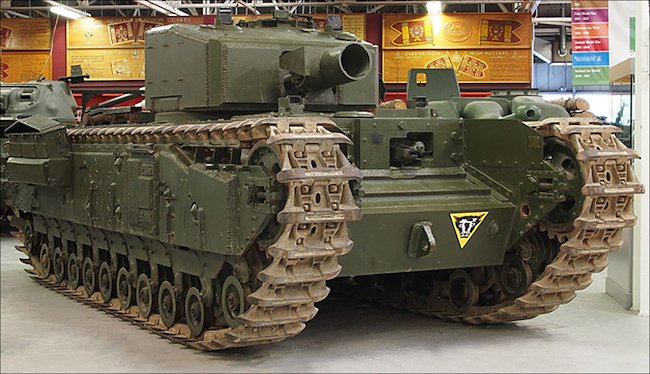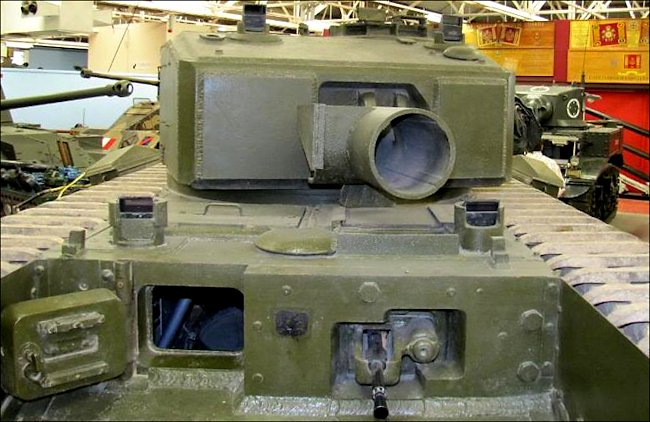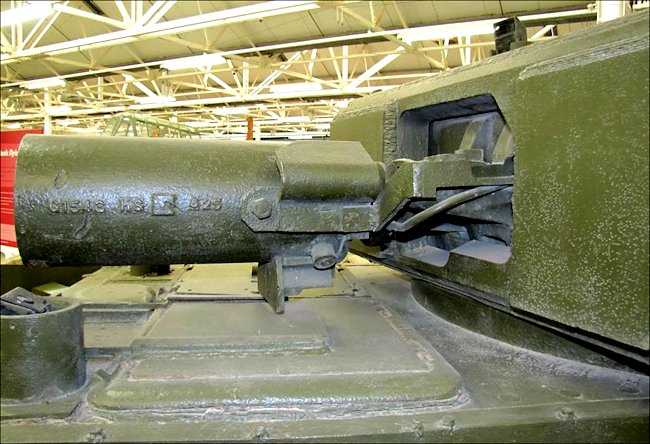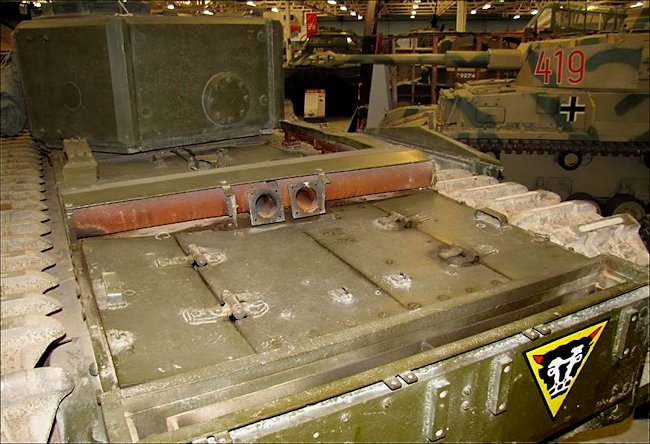Churchill Mark III AVRE
This British Churchill Mark III AVRE was designed to be a D-Day enemy Pill box busting tank. Its service record is not know. It can be found at the Tank Museum, Bovington, Dorset, England. AVRE stands for Armoured Vehicle Royal Engineers.

British Churchill Mark III AVRE Tank at the Tank Museum, Bovington
These specially equipped Churchill tanks were fitted with a Petard 290 mm Spigot Mortar that was capable of projecting a 40 lb (18kg) round with a 28 pound HE high explosive warhead at an enemy fortification. The round was given the nickname of the 'flying dustbin' ('trashcan' for all our American readers) because of its shape. It had an effective range of only 80 yards so it had to get close to its target. The mortar replaced the standard 6pdr main gun.
It could not be reloaded from inside the turret. The gunner had to travers the turret so the gun was over the co-driver's hatch. Only the hands of the co-driver are exposed as he pushed a new round into the Petard barrel. The mortar barrel was 'broken' so the front section would bend and point down into the body of the tank. The hatch had been changed to a sliding hatch to help with this loading procedure.
Apart from the Royal Armoured Corps Tank driver the crew of a Churchill AVRE tank was tank from the Royal Engineers. It was envisioned that the Churchill tank would also act as an armoured personnel carrier taking the crew safely to locations on the battlefield where their skills as demolition experts could be used by the placing of explosive charges. The crew would dismount from the tank to complete these assignments.

British Churchill Mark III AVRE Tank at the Tank Museum, Bovington
By D-day on the 6th of June 180 Churchill Mark III and Mark IV tanks had been converted to AVRE tanks. Notice how thick the additional armour plating was on the front of the turret. This helped the tank get close enough to its target to be able to fire its high explosive short range shell. This additional armour could withstand a hit from the powerful German 88 mm anti tank gun. The hull BESA machine gun was retained for close support and self defence.
The fully restored Bovington Tank Museum Churchill Mk.III AVRE has a few late and post war features that were not fitted to the tanks that landed in Normandy on D-day. These include the three raised panels on the sides of the large hull air intake trunks and the later raised vision Commander’s cupola, also included is the full appliqué armour suite for the hull and turret fitted to later Mk.III/IVs but again rarely seen on the initial Mk.IIIs.
Churchill AVRE smashes D-Day beach wall
Memory of German Unteroffizier (corporal) Henrik Naube, 325th Infantry Division, Normandy 6th June 1944 - The Landing craft were unloading tanks at this point and these were Churchill types. We had been trained to identify Allied planes and tank types, but these Churchills had very short, wide guns that I had not seen in our training pictures. Three of these Churchills flopped down onto the sand and began to move along up the incline to the sea wall.
One of them hit a teller mine, and its track was blown off. That tank revolved in circles hopelessly, spraying sand. Then it came to a halt, one of our 88mm guns opened fire and hit it through the side with an armour piercing shell. My God, that caused a huge explosion in the tank; the top of the hull split open, and burning fuel poured out from the engine decks.
The other two Churchills were also hit; one was knocked over on its side when it ran over the edge of a sand dune. The other was hit repeatedly on the turret but it progressed to the sea wall and it fired its gun repeatedly at the concrete. It caused huge explosions there, and the sea wall disintegrated and collapsed, forming a mound of rubble.

British Churchill Mark III AVRE Tank at the Tank Museum, Bovington
This was presumably what the British wanted, because their men began to rush up this pile of debris and emerge onto the civilian esplanade that ran along the rear of the beach. This meant that they were now on the point of entering the town itself.
The British began to fire on the bunker with rounds from more Churchills that had just landed. This was very inaccurate, with the shells landing haphazardly around us, but the explosions were enormous. In effect, we were blinded by smoke and dust from this shelling, and we decided to cease firing, to conserve our machine gun ammunition and let the gun cool until the smoke cleared.
The British began to fire on the bunker with rounds from their Churchills; this was very inaccurate, with the shells landing haphazardly around us, but the explosions were enormous. In effect, we were blinded by smoke and dust from this shelling, and we decided to cease firing, to conserve our ammunition and let the gun cool until the smoke cleared.

British Churchill Mark III AVRE Tank at the Tank Museum, Bovington
Churchill MkIII AVRE knocks out 88mm bunker on D-Day
Memory of German Unteroffizier (corporal) Henrik Naube, 325th Infantry Division, Normandy 6th June 1944 - I began to doubt if our position would hold. For one thing, we were being bombarded again, with accurate artillery being fired from offshore. These shells were causing the roof of our bunker, which was very thick, to flex and send fragments down onto us. Also, the British sent a tank up over the debris on the sea wall and this advanced along the esplanade towards us.
This was a Sherman tank, a very tall target, and our 88mm hit it immediately on its front plate. However, the shell was obviously high- explosive, not armour-piercing, and it blew away various brackets and hooks on the front of the hull, but the tank continued to advance on us. I could see their infantry forming behind it, using it as cover, and although my MG gunner fired down the sides of the tank hull, he could not hit the men behind it.
The Sherman was firing on the 88mm embrasure as it advanced now, firing very rapidly with explosive, and I could see the shells detonating along the bunker wall where the 88mm was positioned. That 88mm got off one more round, which hit the tank on the right track, blowing it loose. The Sherman skidded to one side, so that its hull flank was exposed, and the 88mm fired again with armour piercing. This went into the hull above the tracks, near the engine, and that tank began to burn almost immediately.
Out of the smoke behind the Sherman, another tank advanced on us; this was a Churchill of the type with the very short, wide calibre gun (Churchill AVRE). This Churchill simply stormed up the roadway, bulldozing aside the Sherman, went through the burning fuel and drove straight up to us without slowing. It was trailing burning gasoline, and although our 88mm hit it on the turret front the round deflected off and went into a nearby house, ripping a hole in the wall.
This Churchill driver was evidently in a furious state, because he took the tank directly up to our bunker, literally a couple of metres from it, and lowered his gun to the area of the 88mm position near me. I saw the big cannon in the turret fire, and with that the whole area of the 88mm embrasure was demolished, in many fragments of concrete and debris.
Read more accounts in these books

